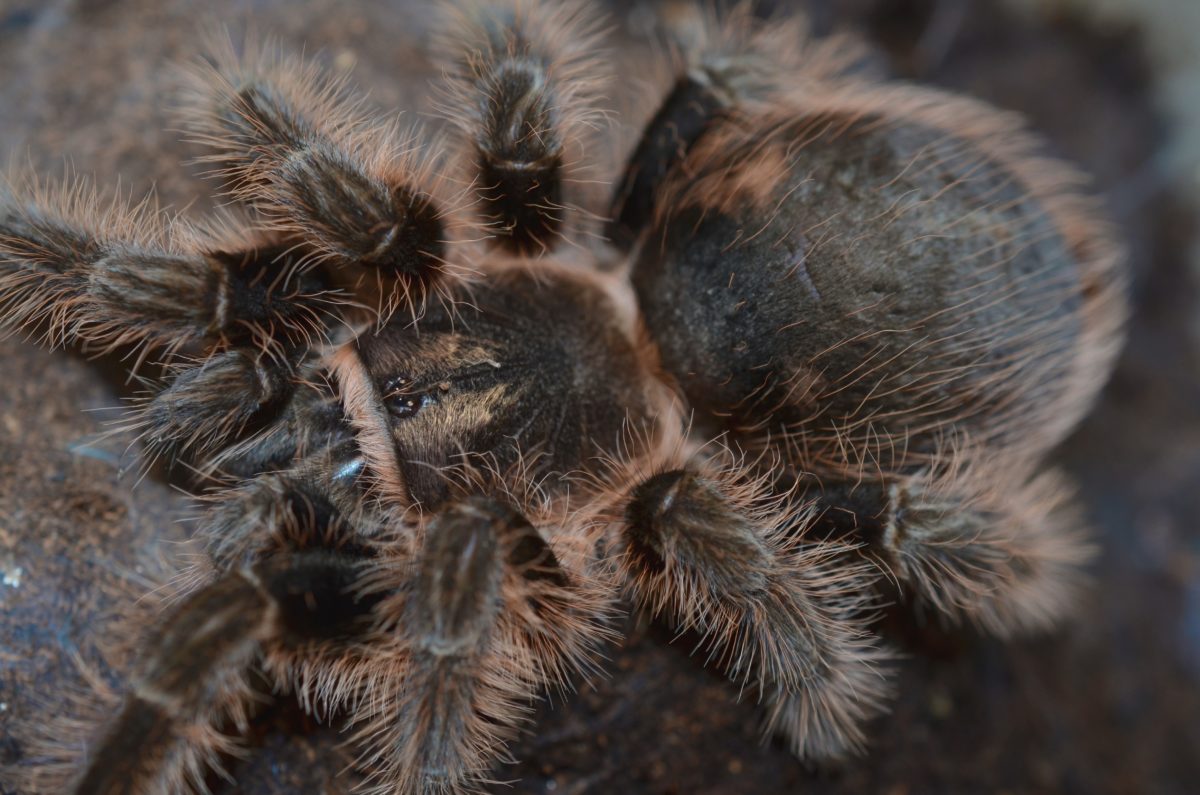Brachypelma emilia is also known as the Mexican Red Leg. This gorgeous tarantula is collected by beginners and experienced keepers alike. Known for being colorful and docile this scrub-land/desert tarantula is extremely hardy. Females are known to live longer than 30 years.
Origin: New World. This scrubland species is native to regions of Mexico’s Pacific coast.
Difficulty: Beginner
Type: Terrestrial
Adult Size: 4.25-5.75″
Growth speed: Slow
Longevity: Males 6+ years, females 20-40 years
Temperament: Docile yet skittish. If agitated they may flee and/or flick urticating hairs.
Bite potency: Mild
Urticating hairs: Yes
Ideal Temperature: 70 to 75°
Humidity: Low to Medium
Fun Fact: As they grow and develop, many Brachypelma and Tliltocatl species may sometimes display a faint or somewhat pronounced triangular pattern on the carapace similar to B. emilia however, B. emilia is the only one from either genus to permanently keep it’s trademark triangle. The contrast is faint at first but the colors will grow bolder with each molt. Although juvenile and adult females display bright red and matte black, the mature males tend to have somewhat brighter color.
Enclosure: Good ventilation is a must and safety should be a top priority when choosing and designing your tarantulas enclosure. The enclosure should not be too tall as to give the spider an opportunity to fall and injure itself. For spiderlings under about 1-1 1/4″ we recommend the Terrestrial Spiderling Enclosure Kit. For specimens over 1″ to about 2″ we recommend the Terrestrial Juvenile Enclosure Kit. Specimens over 2″ and under about 4.5 or 5″ can go into a 7x7x11″ complete terrestrial enclosure. I find they mature are a little smaller than other Brachypelma species so depending on the size of the particular specimen a 7x7x11″ could be a good permanent enclosure. If you have a larger specimen or would like to be sure the final enclosure is definitely large enough we recommend the 8x8x14″ Adult Complete Terrestrial for 2-2.5″ and over specimens. Click HERE to find out how to you measure a tarantula.
Substrate: While most adults will adopt a hide, slings often prefer to burrow. Cocofiber, vermiculite, peat moss and/or potting soil (or a mix) are all excellent substrate choices. Please make sure the substrate you choose is organic and chemical/fertilizer free. Do not use sand, pebbles, rocks or wood chips or anything else that could potentially cut or injure the tarantula.
In many cases a larger specimen would rather adopt or retrofit an existing hide than create it’s own from deep substrate. Cork tubes half buried in substrate are what we use for our adult females. The specimen will excavate one side of the cork tube to it’s liking. I like to think this makes the tarantula feel “at home” while minimizing the time and effort for the spider to settle in.
Spiderlings will often desire to create their own home by excavating a burrow. A tarantula with this talent and preference for tunneling is referred to as an obligate burrower. To encourage this natural behavior we recommend semi-moist substrate at least twice, and ideally three times as deep as the tarantulas DLS. Both the Terrestrial Spiderling and Terrestrial Juvenile Enclosure Kit can be set up to encourage burrowing.
Water: Larger spiders 2” and over should be provided with a shallow water dish in order to drink. The water bowl should be rinsed our every time it is refilled. Being a scrubland species they will not require as frequent misting as an arboreal species however, I recommend keeping one corner of the enclosure lightly misted, especially if there is no water bowl.
Feeding: Adults will eat every 6-14 days depending on the size of the spider and it’s prey. Spiderlings should eat more often, every 5-10 days. Adults may be fed crickets, mealworms or roaches. Spiderlings under .75” can only eat food small enough for it to overpower. This includes pinhead crickets, flightless fruit flies & freshly hatched “pinhead” rusty red roaches. It is not advised to feed your tarantula wild-caught food. It could contain parasites or pesticides that could be fatal to your pet. Keep your tarantulas enclosure clean. food waste left in the enclosure will invite mold, mildew, mites, flies and other pests. It is advised to remove uneaten prey items after 3-12 hours. If using a feeder who will not “bother” a tarantula such as dubia roaches it is alright to leave them in the enclosure as long as they are not causing stress to the specimen. A more detailed feeding, misting & troubleshooting guide can be found here: https://jamiestarantulas.com/guides/
Coloring & Sexual Dimorphism: Spiderlings are slow to obtain their adult colors, but in my opinion experiencing the transformation is part of the fun of raising a tarantula. It will take a while, typically a few years, but around 3/4-1 1/2″ leg-span spiderlings will typically start showing the first signs of adult coloring. After 1 1/2-2″ or so the specimens adult coloring is usually more prominent. Keep in mind these are estimates and it does vary from specimens to specimen. What a joy it is to witness the transformation of an unassuming brown spiderling into a large, colorful tarantula!
Male and females of this species are typically identical in appearance until maturity. Females will become more stocky with age while males are lankier in overall appearance. Mature males will have tibial hooks and often have slightly more striking contrast and color.


